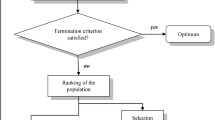Abstract
One of the most widely employed models to evaluate ductile damage and fracture is due to Gurson. An inconvenience of the model is that several material parameters must be determined in order to represent adequately a given experimental behavior. Determination of such parameters is not trivial but can be performed by means of inverse analyses using optimization procedures. In this work, the material parameters are sought by fitting force vs. displacement curves computed using finite element simulation to experimental curves obtained from tensile tests. The resulting optimization problem is non-convex and may present several local minima, thereby posing some difficulties to gradient-based optimization procedures due to the strong dependence on initial estimates of the design variables (the material parameters in this case). An approach based on a genetic algorithm is used in an attempt to avoid this problem. This strategy makes also possible to exploit the parallel nature of evolutionary algorithms as, at each generation, the evaluation of the fitness function of one individual is independent of the fitness of the rest of the population. In this particular implementation, each individual is represented by a gray encoding sequence of genes, the parental selection is performed by means of a tournament selection, the crossover probability is 0.8 and the probability of mutation is 0.05.





Similar content being viewed by others
References
Lemaitre J (1985) Continuous damage mechanics model for ductile fracture. Journal of Engineering Materials and Technology, Transactions of the ASME 107(1):83–89
Gurson AL (1977) Continuum theory of ductile rupture by void nucleation and growth. 1. yield criteria and flow rules for porous ductile media. Journal of Engineering Materials and Technology-Transactions of the ASME 99(1):2–15
Muñoz-Rojas PA, Fiedler T, da Cunda LAB, Öchsner A, Creus G (2007) Parameter identification to simulate a traction test applying Gurson Damage Model. CMNE/CILAMCE, Porto
Ghosh S, Li M, Khadke A (2005) 3D Modeling of shear-slitting process for aluminum alloys. Journal of Materials Processing Technology 167:91–102
Mahnken R (1999) Aspects on the finite-element implementation of the Gurson model including parameter identification. International Journal of Plasticity 15:1111–1137
Mahnken R (2002) Theoretical, numerical and identification aspects of a new model class for ductile damage. International Journal of Plasticity 18:801–831
Abendroth M, Kuna M (2003) Determination of deformation and failure properties of ductile materials by means of the small punch test and neural networks. Computational Materials Science 28:633–644
Abendroth M, Kuna M (2006) Identification of ductile damage and fracture parameters from the small punch test using neural networks. Engineering Fracture Mechanics 73:710–725
Springmann M, Kuna M (2003) Identification of material parameters of the Rousselier model by non-linear optimization. Computational Materials Science 26:202–209
Springmann M, Kuna M (2005) Identification of material parameters of the Gurson-Tvergaard-Needleman model by combined experimental and numerical techniques. Computational Materials Science 33:501–509
Bernauer G, Brocks W (2002) Micro-mechanical modelling of ductile damage and tearing - results of a European numerical round robin. Fatigue and Fracture in Engineering Material Structure 25:363–384
Ashton P, Chase JG, Van Houten EEW (2008) Digital image elasto-tomography: combinatorial and hybrid optimization algorithms for shape-based elastic property reconstruction. IEEE Transactions on Biomedical Engineering 55(11):2575–2583
Chaparro BM, Thulillier S, Menezes LF, Manach PY, Fernandes JV (2008) Material parameters identification: gradient-based, genetic and hybrid optimization algorithms. Computational Material Science 44(2):339–346
Tvergaard V (1981) Influence of voids on shear band instabilities under plane-strain conditions. International Journal of Fracture 17:389–407
Chu CC, Needleman A (1980) Influence of voids on shear band instabilities under plane-strain conditions. Journal of Engineering Materials and Technology-Transactions of the ASME 102:249–256
Cunda LAB, Creus GJ (1999) A note on damage analyses in processes with nonmonotonic loadin. Computer Modeling and Simulation in Engineering 4(4):300–304
Tvergaard V (1982) Material failure by void coalescence in localized shear bands. International Journal of Solids and Structures 18(8):659–672
Stainier L (1997) Modélisation numérique du comportement irréversible des métaux ductiles soumis à grandes déformations avec endommagement, PhD thesis, Université de Liège
Goldberg DE (1989) Genetic algorithms in search, optimization and machine learning, Addison-Wesley Longman
Chakraborty UK, Janikow CZ (2003) An analysis of grey versus binary encoding in genetic search. Information Sciences 156(3–4):253–269
Information on http://pypi.python.org/pypi/processing
Goncalves MB, de Cursi JES (2001) Parameter estimation in a trip model by random perturbation of a descent method. Transportation Research Record 35(2):137–161
Muñoz-Rojas PA, Fonseca JSO, Creus JG (2004) A modified finite difference sensitivity analysis method allowing remeshing in large strain path-dependent problems. International Journal for Numerical Methods in Engineering 61:1049–1071
Muñoz-Rojas PA, Cunda LAB, Cardoso EL, Vaz M Jr., Creus GJ, (2010) A mixed optimization approach for parameter identification applied to the gurson damage model. In: Vaz M Jr., De Souza Neto EA, Muñoz-Rojas PA (eds) Advanced computational materials modelling: from classical to multi-scale techniques, Wiley-VCH, Weinheim, in press
ABNT - NBR ISO 6892 (2002) Metallic materials - tensile testing at ambient temperature (in Portuguese). ABNT, Rio de Janeiro
ASTM - E 8M-86a (1987) Tensile testing of metallic materials. ASTM, Philadelphia
Acknowledgements
The experimental data related to the first example was provided by Prof. Andreas Öchsner and is greatly acknowledged. Prof. Luis Cunda provided the source code of his Gurson damage model implementation. The authors wish to thank the referees for their comments on the manuscript and the financial support provided by FAPESC (Santa Catarina Foundation for Scientific and Technological Research—Project 1775/2006).
Author information
Authors and Affiliations
Corresponding author
Rights and permissions
About this article
Cite this article
Muñoz-Rojas, P.A., Cardoso, E.L. & Vaz, M. Parameter Identification of Damage Models Using Genetic Algorithms. Exp Mech 50, 627–634 (2010). https://doi.org/10.1007/s11340-009-9321-y
Received:
Accepted:
Published:
Issue Date:
DOI: https://doi.org/10.1007/s11340-009-9321-y




